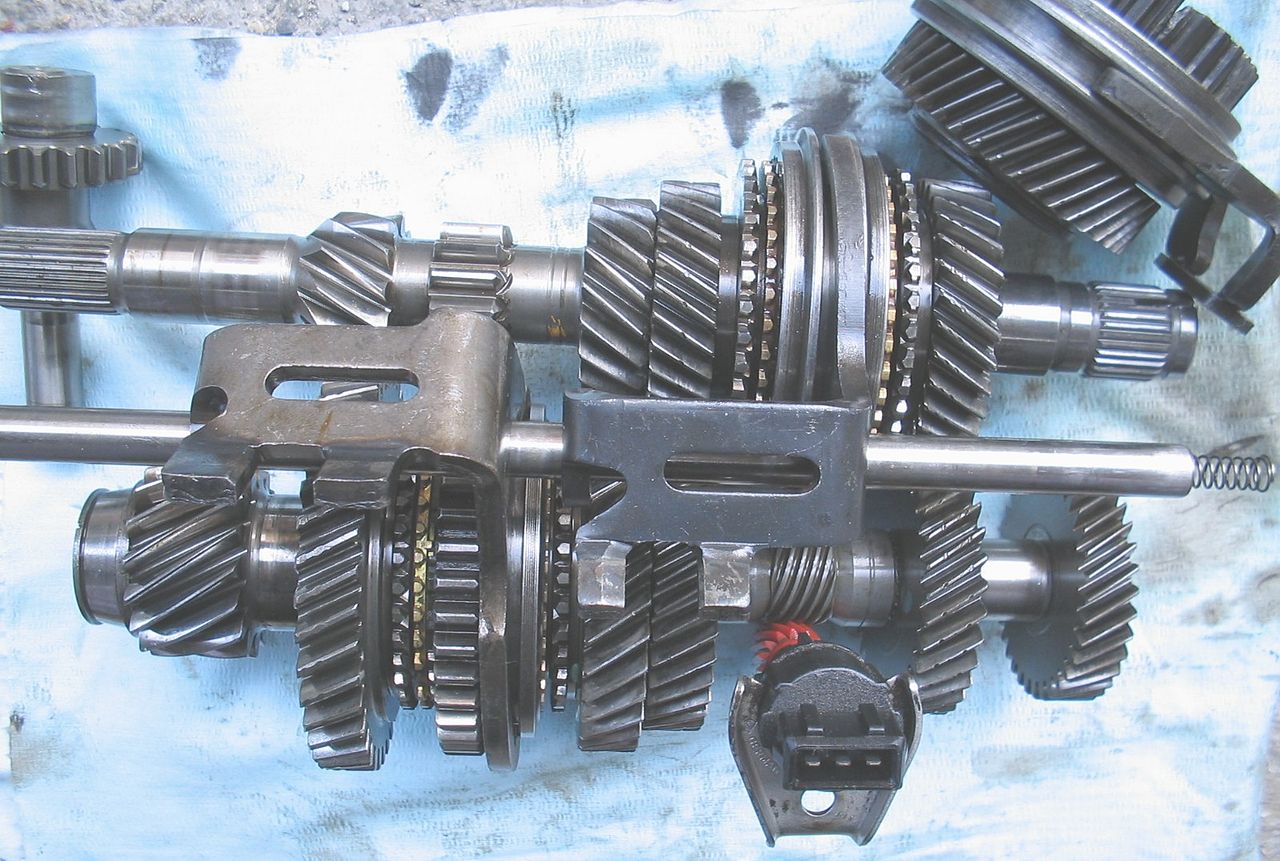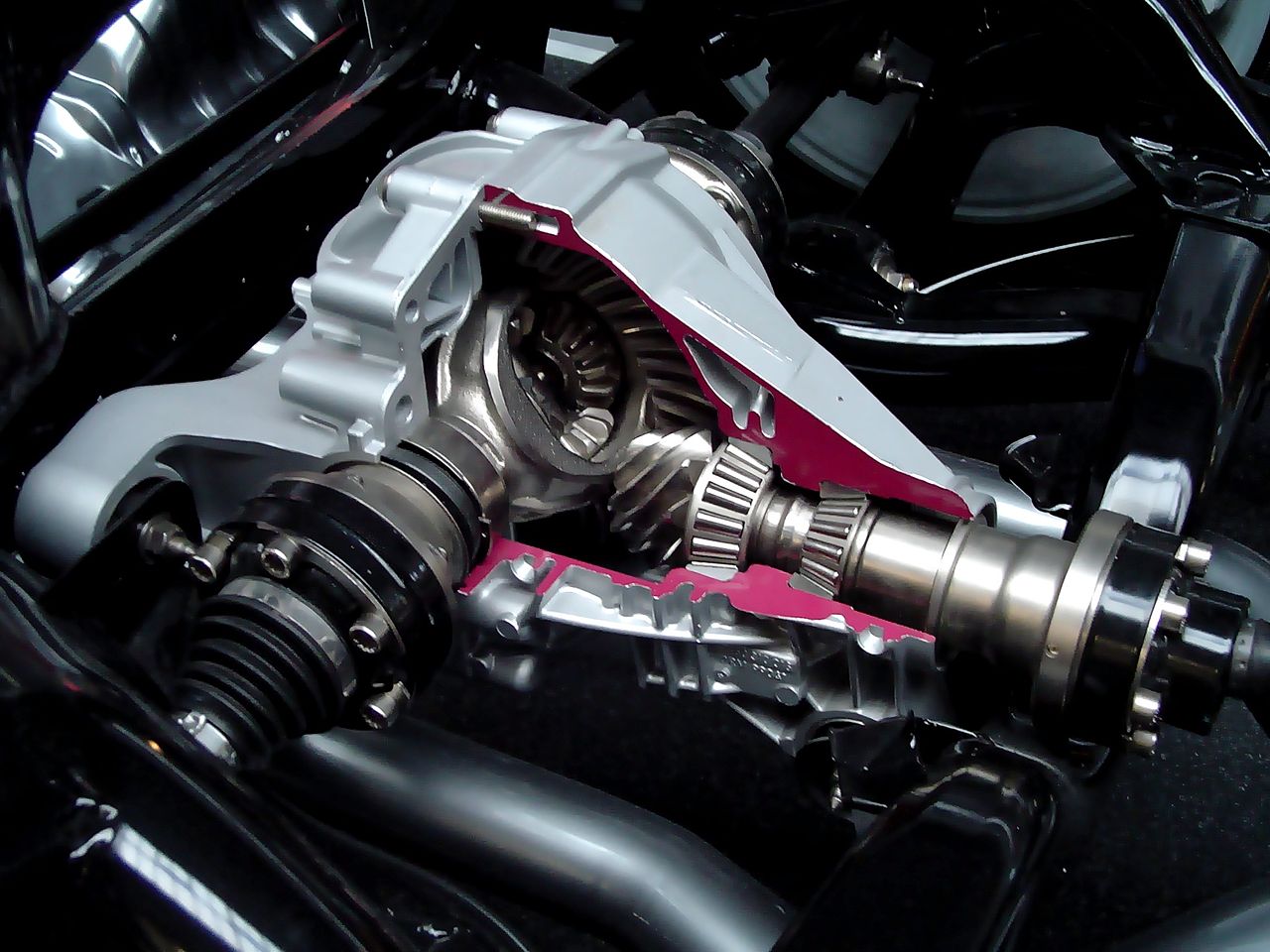The Physics in Cars
The Drive-train
The drive-train is the part of the car that converts all of that energy from the fuel that was converted into energy in the engine into the actual movement and power of the car. It turns the chemical reaction into physical movement or kinetic energy through rotational momentum. The here are many different parts of the drive-train but the main components are the clutch, transmission (and transfer case in some cases), and the axles.
The clutch is the first part of the system as it leaves the engine. It is the part that controls whether the power goes to the transmission or if the engine just spins freely. The clutch works in much the same way as brakes do on a car where there are two plates that pinch down on a separate plate and use frictional forces to slow the car down or in this case to get the car moving. The flywheel and pressure plate are metal discs that are connected to the engine with a metallic or semi-metallic clutch plate in between. When the pedal is depressed the pressure plate is released and allows the engine to spin freely and when it is released the plate pinches the clutch and the friction makes it so the engine turns the transmission and allows the car to go.

(Wikipedia Drive Train) The round section on the back is the clutch and pressure plate.
The transmission is the part that allows you to select gears which change the ratio of rotation between the engine and the output of the car. This works because the engine can only spin so fast before it becomes inefficient and drops out of its optimum power range, by changing the ratio the engine can spin at the same rate while allowing the output shaft to spin at a faster speed. The transmission usually has 5 gears (4 gears and overdrive) that start higher and gets lower as you go through the gears with the final ratio being 1:1 or 1:0.85 in the case of overdrive. The means that for every 1.45 turns of the engine the output shaft will turn once in first gear and so on. This means that the engine has the advantage in the beginning since getting the car rolling takes alot of effort but once it is rolling the engine doesn't have to work as hard to maintain speed. The transmission is a great part since it allows the engine to stay in the rpm range that is best for it to put out the maximum amount of power. The transfer case is an addition to the transmission that splits the output of the transmission to separate drive axles.

(Wikipedia Drive Train) Here is the gears from a manual transmission.
The axles are the last part of the puzzle that take the rotational force from the transmission and sends it to the wheels and makes them rotate that drives the car forward. The axle contains a differential or pumpkin as its often referred to that contains another set of gears called a ring and pinion that will accept the power in one direction and transfer it perpendicularly to each wheel. The axle can have another sort of clutch in the pumpkin that allows both tires to spin in the same direction and put down power at the same time, this is called limited slip that uses the difference in torque between the wheels to allow a pack of clutches to slip or lock up. This is important when you are going around corners since the wheels will be traveling at different speeds as they are at a different radius to the corner.

(Wikipedia Drive Train) Here is a cut away of the differential in an axle.

The drive-train is the part of the car that converts all of that energy from the fuel that was converted into energy in the engine into the actual movement and power of the car. It turns the chemical reaction into physical movement or kinetic energy through rotational momentum. The here are many different parts of the drive-train but the main components are the clutch, transmission (and transfer case in some cases), and the axles.
The clutch is the first part of the system as it leaves the engine. It is the part that controls whether the power goes to the transmission or if the engine just spins freely. The clutch works in much the same way as brakes do on a car where there are two plates that pinch down on a separate plate and use frictional forces to slow the car down or in this case to get the car moving. The flywheel and pressure plate are metal discs that are connected to the engine with a metallic or semi-metallic clutch plate in between. When the pedal is depressed the pressure plate is released and allows the engine to spin freely and when it is released the plate pinches the clutch and the friction makes it so the engine turns the transmission and allows the car to go.

(Wikipedia Drive Train) The round section on the back is the clutch and pressure plate.
The transmission is the part that allows you to select gears which change the ratio of rotation between the engine and the output of the car. This works because the engine can only spin so fast before it becomes inefficient and drops out of its optimum power range, by changing the ratio the engine can spin at the same rate while allowing the output shaft to spin at a faster speed. The transmission usually has 5 gears (4 gears and overdrive) that start higher and gets lower as you go through the gears with the final ratio being 1:1 or 1:0.85 in the case of overdrive. The means that for every 1.45 turns of the engine the output shaft will turn once in first gear and so on. This means that the engine has the advantage in the beginning since getting the car rolling takes alot of effort but once it is rolling the engine doesn't have to work as hard to maintain speed. The transmission is a great part since it allows the engine to stay in the rpm range that is best for it to put out the maximum amount of power. The transfer case is an addition to the transmission that splits the output of the transmission to separate drive axles.

(Wikipedia Drive Train) Here is the gears from a manual transmission.
The axles are the last part of the puzzle that take the rotational force from the transmission and sends it to the wheels and makes them rotate that drives the car forward. The axle contains a differential or pumpkin as its often referred to that contains another set of gears called a ring and pinion that will accept the power in one direction and transfer it perpendicularly to each wheel. The axle can have another sort of clutch in the pumpkin that allows both tires to spin in the same direction and put down power at the same time, this is called limited slip that uses the difference in torque between the wheels to allow a pack of clutches to slip or lock up. This is important when you are going around corners since the wheels will be traveling at different speeds as they are at a different radius to the corner.

(Wikipedia Drive Train) Here is a cut away of the differential in an axle.